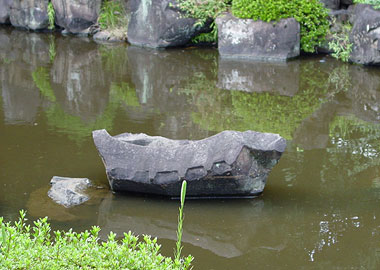|
||
 |
||

Toukouji
υ (Yamanashi)
@
(C)2001 Japanese Architecture and Art Net Users System.@No reproduction or republication without written permission.
fΪΜeLXgEΚ^ECXgΘΗASΔΜRecΜ³f‘»E]ΪπΦΆά·B
|
||||||
| @ | ||||||
| houraibune@ HM | ||||||
| KEY WORD :@architecture / gardens | ||||||
| @ | ||||||
| Also called a boat stone funa-ishi MΞ or treasure-boat stone takarabune-ishi σMΞ. Lit. Penglai boat. A garden stone in the shape of a boat. The houraibune represents a boat that travels to and from Mt. Penglai *Houranisan HR where, according to legend, ships landed to gather secret treasures and the elixir of immortality. Penglai boat stones are often shown in close proximity to stones or planted islands representing Mt. Penglai, *houraiseki HΞ, *hourai gantou Hβ. They are usually placed in ponds, but are sometimes used in dry landscape *karesansui ΝR gardens such as that at Daitokuji Daisen-in εΏεε@ in Kyoto. Stones chosen as houraibune usually have the distinctively curved shape of old ships: they are flat in the middle, sharply upturned at the front, and upturned less dramatically at the rear. Ships on their way to Penglai are represented with thicker stones suggesting empty boats riding high in the water; boats coming back are represented with thinner stones suggesting they are weighed down with goods. In older gardens most of the houraibune stones are thick and thus show outgoing boats, while Edo period gardens usually show thinner returning ships. Good examples of houranibune in pond gardens can be seen in the gardens at Toukouji υ in Yamanashi prefecture, Joueiji νh in Yamaguchi prefecture, Senshuukaku ηHt in Tokushima prefecture, and Rengeji @Ψ in Kyoto. | ||||||
| @ | ||||||
 Toukouji
υ (Yamanashi)
|
||||||
@ |
||||||
| REFERENCES: | ||||||
| @ | ||||||
| EXTERNAL LINKS: | ||||||
| @@ | ||||||
| NOTES: | ||||||
| @ | ||||||
(C)2001 Japanese Architecture and Art Net Users System.@No reproduction or republication without written permission. fΪΜeLXgEΚ^ECXgΘΗASΔΜRecΜ³f‘»E]ΪπΦΆά·B |
||||||
| @ |